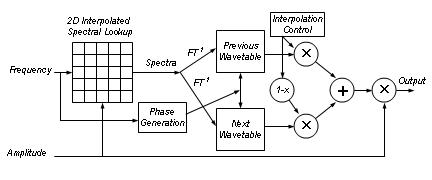
Spectral Interpolation Synthesis
Spectral Interpolation Synthesis is based on the idea that the power spectrum produced by a wind instrument is mostly determined by the pitch (or more properly, the fundamental frequency) and the loudness (intensity of sound). As the loudness changes, the (short-term) spectrum evolves. Spectral Interpolation Synthesis is controlled by time-varying pitch and amplitude function. At each moment, the current pitch and amplitude are used to find the appropriate output spectrum, which is generated. In practice, spectra are computed at a modest rate of perhaps 20 to 100 per second, and interpolation is used to make spectral changes smooth.
Part of the synthesis problem is generating appropriate control functons. Research has shown that we are very sensitive to the variation of loudness and pitch, so even if the synthesis is perfect, synthetic instruments will sound real only if they are controlled by plausible functions. Furthermore, research has shown that amplitude variation is highly dependent upon musical context, for example whether the following note is higher or lower in pitch, and how that note is articulated.
The most recent work on Spectral Interpolation Synthesis aims to create synthesis models automatically from performances. The idea is for the program to learn how to convert a sequence of notes in a score, including various phrase markings, slurs, and other articulation symbols, into amplitude and pitch control functions for Spectral Interpolation Synthesis.
Resources:
Some Spectral Interpolation Synthesis papers are online.
Some Spectral Interpolation Synthesis sound examples are available for listening.
